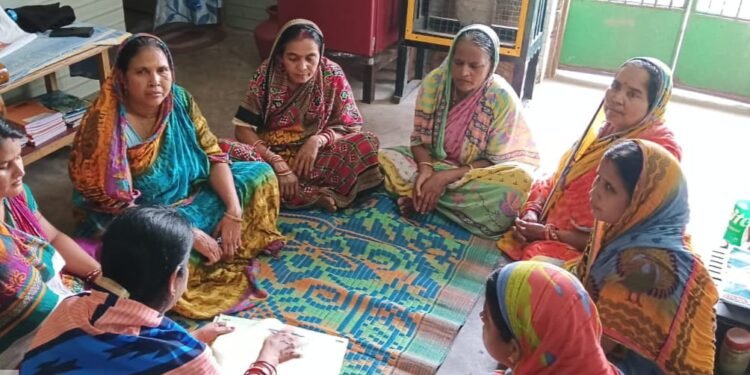By Tanuja Mohanty
Bhubaneswar: The Deendayal Antyodaya Yojna-National Rural Livelihood Mission (DAY-NRLM), an ambitious flagship scheme of the Government of India, implemented since 1st April 2012 is dedicated to reducing rural poverty by promoting sustainable livelihoods, enhancing social inclusion, and empowering women through community-driven institutional frameworks. NRLM’s main objectives include building self-managed and financially sustainable institutions for the rural poor, fostering self-reliance, and providing effective livelihood support.
Strong institutional platforms of the poor empower the poor households and enable them to build-up their own human, social, financial and other resources. They, in turn, enable them to access their rights, entitlements and livelihoods opportunities, including services (both from the public and private sector). The social mobilization process enhances solidarity, voice and bargaining power of the poor. These processes enable them to pursue viable livelihoods based on leveraging their own resources, skills and preferences. Thus, they come out of abject poverty and do not fall back into poverty.

NRLM ensures that at least one member from each identified rural poor household, preferably a woman, is brought under the Self Help Group (SHG) network in a time bound manner. Subsequently, both women and men to be organized for addressing livelihoods issues i.e. farmers organizations, milk producers’ cooperatives, weavers associations, etc. All these institutions are inclusive and no poor would be left out of them. NRLM ensures adequate coverage of vulnerable sections of the society such as SC/STs, minorities, specially-abled (Divyangjan), while keeping in view the ultimate target of 100% coverage
Strong and vibrant institutions of the poor such as SHGs and their village level and higher level federations are necessary to provide space, voice and resources for the poor and for reducing their dependence on external agencies. They empower them and also act as instruments of knowledge and technology dissemination, and hubs of production, collectivization and commerce. NRLM, therefore, focuses on setting up these institutions at various levels.
Aligned with this vision, Odisha Livelihoods Mission (OLM), which has been implementing the DAY-NRLM scheme in the state, undertakes various initiatives, including institution building, livelihood promotion, financial inclusion, and capacity development, to ensure sustainable economic empowerment and inclusive rural growth across Odisha. OLM, is pivotal in executing the Central Government’s flagship initiative ‘Lakhpati Didi,’ aiming to empower rural women by facilitating annual earnings of 1 lakh or more. Inclusion of women into SHGs provides them with necessary financial services, skill enhancement, and market linkages, transforming rural women into empowered entrepreneurs.
SHG is the gateway to access all the benefits and services entailed under the DAY-NRLM scheme. Therefore, NRLM undertakes the universal social inclusion approach, by bringing each and every rural poor household into the SHG fold. In the endeavour to achieve 100% inclusion of rural women (one from one household) into SHGs, OLM started a massive social mobilization campaign from 8th March, on the occasion of the International Women’s Day, till 31st March 2025 across Odisha. This campaign aimed to include all targeted rural households into Self-Help Groups (SHGs), with a focus not to leave behind any poor and marginalized family to get into the SHG fold. Apart from this, special emphasis was given to form SHGs of specially-abled (Divyangjan) and elderly, i.e. all elders aged 55 years and above. As per the NRLM guidelines, both male and female are covered under the Divyangajan and elderly SHGs.
The Mobilization Campaign involved a series of activities, starting with mapping rural households and potential women members who are not yet part of any SHG. Following this, inactive SHGs were revitalized, ensuring all groups are actively contributing to community development. OLM will facilitate the opening of bank accounts for new SHGs and ensured their structured and sustainable economic empowerment. The effort resulted into inclusion of 4,12,548 left-out eligible households into SHGs,.
Significantly, the campaign laid special emphasis on social inclusion by proactively integrating specially-abled (Divyangjan) and elderly community members into SHGs. Recognizing their unique potential and ensuring their active participation, a total of 1,667 Divyangjan individuals and 4,495 elderly persons were brought into the SHG fold. OLM is meticulously facilitating tailored livelihood activities that match their specific abilities, thereby not just promoting economic self-reliance but also nurturing a sense of dignity, social acceptance, and inclusive community growth.
The campaign also emphasized on formation and strengthening of Producer Groups, facilitating livelihood opportunities through agriculture, livestock, and allied activities etc.
A notable feature of this campaign was its extensive outreach into the remotest villages of Odisha, overcoming geographical and infrastructural barriers to ensure maximum coverage and participation. Field personnel actively engaged communities that previously had minimal access to institutional support, thereby significantly enhancing social inclusion at grassroots levels.
The campaign was thoroughly monitored at different levels to achieve its desired outputs. The State Mission Management Unit prepared the roadmap and have been monitoring the activity on daily basis. The District Mission Management Unit and the Block Mission Management Unit were engaged directly with the field functionaries to capture day to day progress. The campaign targets 100% inclusion of identified households, guaranteeing comprehensive institutional support to women entrepreneurs.
Through targeted initiatives like this Mobilization Campaign, OLM is advancing towards realizing the vision of a self-reliant, empowered, and economically inclusive Odisha.






